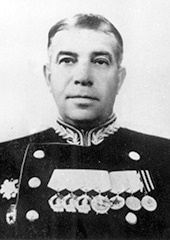Arkady Yermakov
This article may be expanded with text translated from the corresponding article in Russian. (August 2018) Click [show] for important translation instructions.
|
Arkady Nikolayevich Yermakov | |
|---|---|
 | |
| Born | (1899-09-22)22 September 1899 Mtsensk, Oryol Governorate, Russian Empire |
| Died | 25 October 1957(1957-10-25) (aged 58) Moscow, Soviet Union |
| Allegiance | Russian SFSR |
| Service/branch | Soviet Army |
| Years of service | 1918–1957 |
| Rank | Lieutenant-General |
| Commands held |
|
| Battles/wars | Russian Civil War Winter War German-Soviet War |
| Awards |
|
Arkady Nikolayevich Yermakov[a] (22 September [O.S. 10 September] 1899 – 25 October 1957) was a Soviet Army lieutenant general.
Yermakov served as a Red Army commander during the Winter War and World War II. He served as the Senior Military Adviser to the Chinese People's Liberation Army during the Cold War.
Contents
1 Early life and career
2 Winter War
3 World War II
3.1 Early War
3.2 Battle of Moscow and the Yermakov Operational Group
3.3 Arrest, Court Martial, and Reinstatement
4 Post-war service
5 Awards
5.1 Soviet orders and medals
5.2 Foreign awards
6 Notes
7 References
7.1 Citations
7.2 Bibliography
Early life and career
Winter War
During the Finnish Winter War, then Kombrig Yermakov commanded the Soviet 100th Rifle Division which was involved in the breakthrough of the Mannerheim Line which brought about the end of the war. He authored a report about the performance of Soviet Teletanks in that campaign.[1]
World War II
Early War
Battle of Moscow and the Yermakov Operational Group
During the Battle of Moscow, General Yermakov came to command what was known as the Yermakov Operational Group which grouped the 3rd Army, 13th Army, and 50th Army under his operational control in the Bryansk Front fighting against German Army Group Center. Ermakov's command was controversial for his focus on offensive operations from mid August to late September 1941. Marshal Yeryomenko credited his command's actions for significantly weakening the strength of the German Attack Groupings. Conversely, General Sanalov criticized him for paying insufficient attention to the defense during this time, leading to later losses.[2]
Arrest, Court Martial, and Reinstatement
On January 29, 1942, while commander of the 50th Army, General Ermakov was arrested and court-martialed. He was later released, reinstated appointed Deputy Commander of the 20th Army later that year in June. He was to become commander of the 20th Army on March 20, 1943.
Post-war service
He was Senior Military Adviser to the Chinese People's Liberation Army between 1953 and 1957, and died shortly after serving in that position.
Awards
Soviet orders and medals
Foreign awards
Notes
^ Russian: Аркадий Николаевич Ермаков
References
Citations
^ https://nationalinterest.org/blog/the-buzz/russia-tried-conquer-finland-flamethrower-robot-tanks-25629?page=0%2C1
^ Sokolov 2015, p. 112.
Bibliography
Lopukhovsky, Lev (2013). The Viaz'ma Catastrophe, 1941: The Red Army's Disastrous Stand Against Operation Typhoon. Translated by Stuart Britton. Solihull: Helion. ISBN 9781908916501..mw-parser-output cite.citation{font-style:inherit}.mw-parser-output q{quotes:"""""""'""'"}.mw-parser-output code.cs1-code{color:inherit;background:inherit;border:inherit;padding:inherit}.mw-parser-output .cs1-lock-free a{background:url("//upload.wikimedia.org/wikipedia/commons/thumb/6/65/Lock-green.svg/9px-Lock-green.svg.png")no-repeat;background-position:right .1em center}.mw-parser-output .cs1-lock-limited a,.mw-parser-output .cs1-lock-registration a{background:url("//upload.wikimedia.org/wikipedia/commons/thumb/d/d6/Lock-gray-alt-2.svg/9px-Lock-gray-alt-2.svg.png")no-repeat;background-position:right .1em center}.mw-parser-output .cs1-lock-subscription a{background:url("//upload.wikimedia.org/wikipedia/commons/thumb/a/aa/Lock-red-alt-2.svg/9px-Lock-red-alt-2.svg.png")no-repeat;background-position:right .1em center}.mw-parser-output .cs1-subscription,.mw-parser-output .cs1-registration{color:#555}.mw-parser-output .cs1-subscription span,.mw-parser-output .cs1-registration span{border-bottom:1px dotted;cursor:help}.mw-parser-output .cs1-hidden-error{display:none;font-size:100%}.mw-parser-output .cs1-visible-error{font-size:100%}.mw-parser-output .cs1-subscription,.mw-parser-output .cs1-registration,.mw-parser-output .cs1-format{font-size:95%}.mw-parser-output .cs1-kern-left,.mw-parser-output .cs1-kern-wl-left{padding-left:0.2em}.mw-parser-output .cs1-kern-right,.mw-parser-output .cs1-kern-wl-right{padding-right:0.2em}
Sokolov, Boris Vladimirovich (2015). Marshal K.K. Rokossovsky: The Red Army's Gentleman Commander. Translated by Stuart Britton. Solihull: Helion. ISBN 9781909982109.
Vozhakin, Mikhail Georgievich, ed. (2005). Великая Отечественная. Командармы. Военный биографический словарь [The Great Patriotic War: Army Commanders: Military Biographical Dictionary] (in Russian). Moscow: Kuchkovo Pole. ISBN 5860901135.